These are the minutes of the sixth annual W3C Technical Plenary held on 1 March 2006 at the Sofitel Royal Casino Hotel in Mandelieu, France. In addition to the day-long event, thirty W3C Working Groups and Interest Groups held face-to-face meetings over four days at the same location. The public plenary consisted of nine sessions. This meeting record is transcribed from the IRC log (Member only) and is not verbatim. Please send corrections to the W3C Communications Team.
W3C wishes to thank Plenary Day scribes Klaus Birkenbihl, Janet Daly, Sandro Hawke, Ivan Herman, Ian Jacobs and Felix Sasaki; and photographers Kazuyuki Ashimura [archive: Session 2, Sessions 3, 4 and 5, Sessions 6 and 7, Sessions 8 and 9], Klaus Birkenbihl [archive], Bert Bos, Paul Downey, Thomas Roessler [archive] and others.
Informally, Dan Connolly (W3C), Elias Torres (IBM), and Norm Walsh (Sun Microsystems) and others posted reflections on this year's plenary.
The first annual W3C Technical Plenary took place on 28 February 2001, the second on 27 February 2002, the third on 5 March 2003, the fourth on 3 March 2004 and the fifth on 2 March 2005.
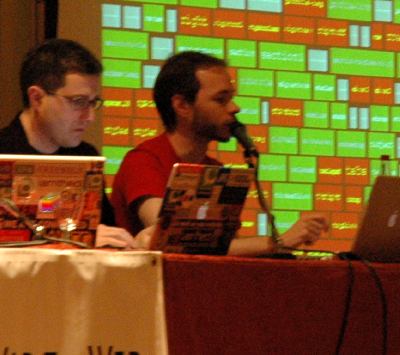
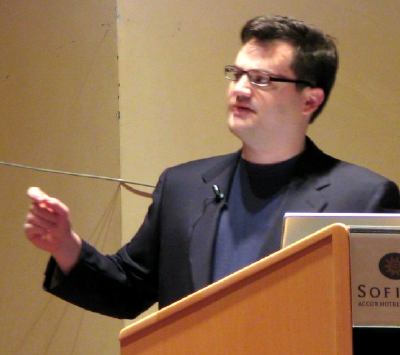
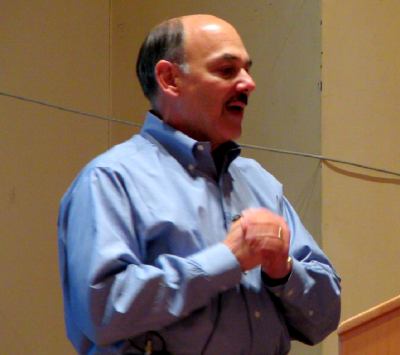
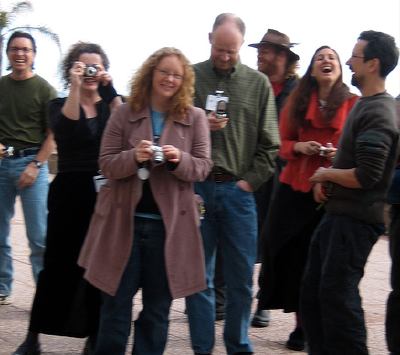
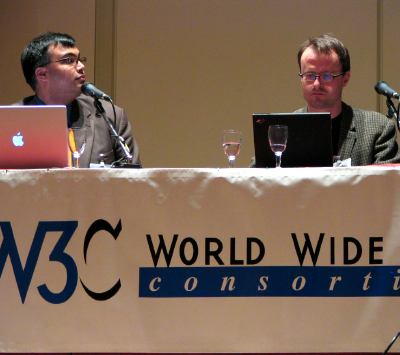


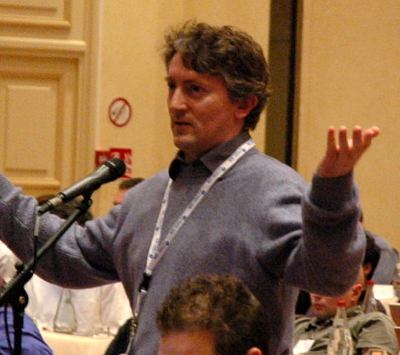

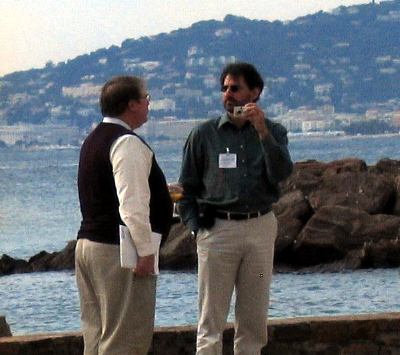
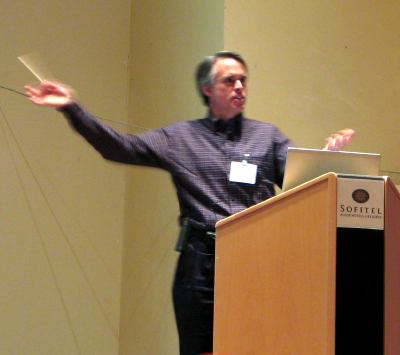
Meeting Chair: Steve Bratt (W3C Chief Executive Officer) [slides]
rohit: that's a nice svg graphic of specs completed he had two slides ago -- anyone have a link yet? is it autogenerated?
janet: autogenerated, yes
ivan: rohit, the svg itself is: http://www.w3.org/2003/03/recsslideWithGroups.svg
ivan: png version: http://www.w3.org/2003/03/recsslideWithGroups.png
ivan: it is regenerated when a new document is published
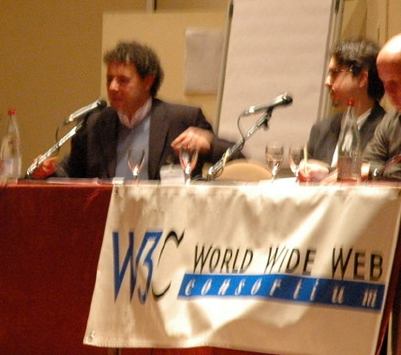
Moderator: Mark Nottingham (Yahoo). Presenters and Topics:
Mark Nottingham: Users expect more with regards to the use of their data, and their reuse. Many new Web sites are becoming more open to reuse and repurposing of information. This brings about legal considerations. It also brings about different technical challenges. Daniel Weitzner is looking at this from the legal/privacy side, while my perspective is more technical. Each panelist will talk for 3-5 minutes about their perspectives.
Daniel Appelquist (Vodafone): Vodafone is a carrier with 179 million customers worldwide. We have a key stake in providing customers with services that enable them to use/generate/reuse data. Rather than talk about our company's strategy for customer privacy, I can talk about location-based services code of practice. This governs the use of location data, and apps which use that. Location based services code of practice was developed by different participants across Europe. This is a voluntary practice. We are using location-based info from our cell users, which is not quite GPS, but effective. The four areas are "Corporate, Friend finder, ... and child location". So, how do we enable apps like child location and address privacy concerns in a voluntary way?
Daniel Appelquist: Much of these codes are alternatives to legislation and regulation. The cornerstones are address validation (sms and sms reply), address access verification, opt-in policy for making your location read, regular reminders about use of your location, use of "anytime stop," transparency of activity. All of these are applicable to the child location application in particular. The challenges apply only to operator based location services, not GPS.
Daniel Weitzner (W3C) speaking for Sandro Hawke (W3C): TimBL told us we all had to use FOAF (Friend of a Friend) files. FOAF is an RDF file that identifies you, and it is an opt-in app. TimBL told Sandro that he had to use FOAF. Sandro is already a live journal / FOAF user, and an Orkut user. In considering what to do in terms of revealing all connections by combining the two files from a personal context into a professional context, 2/3 of the people he asked were ok with being identified in a professional context, but 1/3 was vehemently opposed, based on data mining concerns. They wanted to control the context in which their identity was used. The Well, an early social networking site, operated on ownership of words. However, your ownership of words describing relationships with others is not so simple.
SusanL: "You own your own words." WELL welcome message, written by Stewart Brand
Bruno von Niman (ANEC): I represent ANEC, a EU funded entity that represents the interests of consumers in standards development. It is all of us, after hours. It covers ICT, child safety (helmets, for example) and other areas. I represent EU consumers, essentially the issues we face are wide and complex. To isolate your professional life from your personal life -- this boundary is getting more fuzzy. Our question has to do with developing a profile of myself that brings with it rights as they apply to the citizen as one moves through different environments. Issues on privacy and child protection -- when does a child have the option to turn off tracking? At what age? Is there a way for us to distinguish the difference between service outage and genuine danger with respect to tracing? In healthcare issues -- how do we develop systems for monitors of health conditions, and who gets access to the information? Or for example, the publication of tsunami victims led to thefts of victims' property in Sweden.
Daniel Weitzner (W3C): The Web made it possible for everyone to be a publisher, but the reality is much more that everyone is a consumer. With the possible exception of email and IM. Now, we get closer to everyone publishing (blogs, wikis). www.myspace.com is a social networking site, mostly late teens, with 50 million users. The company is owned by News Corp. Myspace has 50 million users -- more than all the viewers of all the News Corp stations in the world. At a recent meeting, a conversation took an interesting turn with respect to Myspace. One user was recently found guilty of murder, and his profile would have been an alert to most people reading the profile. There's reason to think of this site as a pool of targets. One of the CPS people said, "if only we could get kids to protect their privacy, they would be safer." And yet, most of these users have a different level of tolerance to exposure and information sharing. Online, we're seeing different practices and may need another way to look at the issue. As for the Google filtering in China case. We may look (legally) at how international law and human rights law intersect. Google says they will indicate when results were blocked. What does "alerting the user" really mean?
Question for the panel: What shifts are we seeing in content creation and copyright license practices?
Mark Nottingham: We see more use of tools, such as microformats, that make that sort of data available for repurposing?
Bruno von Niman: Following Sony's copyright policy with CDs, the EC published "consumer digital rights" which included the right to protect personal information, right to make back-ups for personal needs, right to use and display media at home.
Daniel Appelquist: The issue of reviews and user-generated content generated a thread on trust -- how can I trust the source of particular information. It could be consumer decisions, or more critical life decisions. It's important to grapple with the trust issue, and understand the provenance of information. Making the source of information transparent is crucial. From a carrier perspective, we see a case for encryption and digital signatures. A SIM card is an identifier we trust, for example. Getting that level of trust on content is a challenge, and is important.
Daniel Weitzner: There is an interesting access between privacy and personal information. It would be great to come up with a good way to create collective wisdom. We don't have that ability yet because we don't have reliable mechanisms for it at the personal level. Looking at the average search engine/webmail/location information convergence, we're tolerating a staggering amount of personalization and we want that.
Question for the panel: Are privacy expectations changing?
Sandro Hawke (W3C): Part of why people have lower privacy expectations and demands is that pseudonymity has taken hold. Since they aren't being pursued in other media, they still feel protected.
Bruno von Niman: Currently, there are requirements for logging of exchanges and maintaining logs for 5 years. Trust needs to be established. For example, when my operator does not allow me to use a different ring tone, it reduces my trust of the carrier. With respect to privacy, I want to have a portable profile through the Web. Those things are not portable.
Sandro Hawke: This is why I like OpenID as a user protocol.
Bruno von Niman: EU has a law that requires that all patient journal data must be interoperable in 5 years. This data must be provided on SIM cards, eventually. They are changing very much.
Al Gilman: There is prior art in the area of customized services. There is a real issue of public safety as well. I was surprised not to hear that mentioned. The MD who treats you in the emergency room when unconscious -- there are trust issues as well.
Bruno von Niman: Emergency telecoms (EMTA) is critical as well. Finding systems to reach the right audience in the right language, in a timely fashion, is a major challenge.
Al Gilman: Is ATEC aware of the meeting stateside of access to emergency information?
Bruno von Niman: Yes.
Jeremy Carroll: I found this session incredibly hard. You're raising privacy concerns that are very simple cases. In my own case, there is a variety of information sources that can be combined and a profile of me could be made available. I find this deeply deeply threatening.
karl: +1 to jeremy carroll
Phil: +1 to Jeremy
Daniel Weitzner: You raise what are the hardest privacy problems and what have little to do with the actual technologies. They have to do with larger facts about our society. At UCal Berkeley there was a face recognition experiment going on. There is a walkway through campus called democracy way, where the 68 protests occurred. At the same time, there was a demonstration by Iranian students, protesting the repressive regime. The photos were posted on the Web, and the students were identified by name. Once the demonstrators realized this, they had to work to get the site taken down.
Bruno von Niman: It has to do with who cares and why.
Mark Nottingham: Just as security people say that security has to be integrated, privacy has to do the same.
Janet Daly (W3C): Bruno's remark about the tsunami reminded me of Boston newspapers that announce funerals. Always a family friend would stay in the house to protect it from theft during a funeral. Talking about trust, if you don't know the perspective of the media source, if you don't realize there is a perspective -- a slant -- from the source, you're not going to be able to identify the information as presented or understand whether to trust the presenter.
Chris: finding subversives based on datamining amazon wishlists: http://www.applefritter.com/bannedbooks
Hixie: is there a tp chat channel this year?
KevinLawver: #chat?
Hixie: i guess "there is now" is the answer you were implying :-P
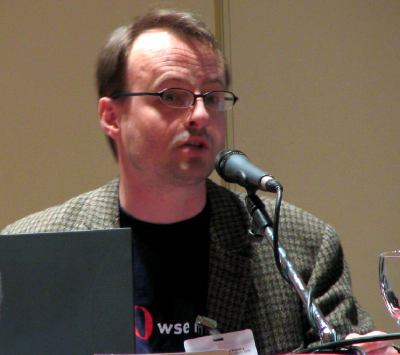
Moderators: Tantek Çelik (Technorati, CSS Working Group) and Dan Connolly (W3C; URI Interest Group, RDF Data Access Working Group, Technical Architecture Group). Presenters and Topics:
Ian Hickson (Google): I did some Google searches to learn about how markup is used. Millions of pages use non-standard elements; the names of these elements give interesting insights into author demands.
[Ian Hickson shows 1000 most-used elements on the Web. Lots of syntax errors and presentation markup is used. A fair amount of "semantic markup" as well. Shows list of non-standard elements. For instance a lot of authors using elements related to headers.]
JacekK: how is XML a semantic tag? 8-)
Ian Hickson: An example --
"subtitle"
... An example -- grouping content as "article" or "footer"
... An example: "date"
(including dc:date)
Ian Hickson: Another one is "license"... Microsoft has contributed some of the non-standard tags ("smart tags").
DanC_lap: "rdf:rdf is popular enough to be in the top 1000 HTML elements" -- IH
Ian Hickson: The issue is that these elements are not defined in any specs --- no semantics. Lots of markup for menus. A couple of elements for photos, for advertisements, for prices. "Warning", "Copyright". Class names have no semantics. Web browsers can't make use of them.
DanC_lap: anybody remember the <menu> tag in HTML 1.x?
anne: yeah, it was deprecated in HTML 4.01, not?
Ian Hickson: I looked at slightly more than 1 billion documents. More information on my talk is available at: http://code.google.com/webstats/index.html
Tantek Çelik (Technorati) presents: What are microformats? (slides)
[Tantek Çelik shows what you can do with the tech plenary agenda. Shows a transformation of the TP agenda]
dbaron: http://feeds.technorati.com/contacts/http://www.w3.org/2006/03/01-TechPlenAgenda.html
[Transformed to vcf and adds 34 new cards to TC's addressbook]
Tantek Çelik: Contact info of TP speakers is scraped from the TP agenda. The TP agenda page has hCard markup, a microformat in the markup -- hCard converted to vCard, then seamless import into a typical address book. [Shows a transformation of the TP agenda to event information. List of sessions appears in Tantek's calendar program.]
dbaron: webcal://feeds.technorati.com/events/http://www.w3.org/2006/03/01-TechPlenAgenda.html
DanC_lap: <grumble>webcal:// ... unregistered URI schemes</grumble>
dbaron: DanC_lap, (response to grumble) http://lists.w3.org/Archives/Public/www-tag/2005Dec/0027
DanC_lap: thanks for the reminder, dbaron
dbaron: or http://feeds.technorati.com/events/http://www.w3.org/2006/03/01-TechPlenAgenda.html
Tantek Çelik: DB too. Same with hCalendar to iCalendar to a calendar program. [Walks through an hCard markup example]
dom: [the W3C Team-internal phonelist uses hCard; I imported thus the list of phone numbers for all of my colleagues on my cell phone based directly on the said HTML page]
[Tantek Çelik presentation continues...]
[Road to Microformats]
2000-2001: Designers start to use CSS
2002: designers rediscover semantic XHTML
2003: CSS Zen Garden launched (Showed that you could change
presentation without changing markup)
Also in 2003, blogging tools adopt more semantic XHTML. Use of "id"
increases (replacing empty <a name="foo"></a>)
"rel" attribute rediscovered.
Bloggers conflate people and URIs into "blog rolls"
Blogrolls emerge as decentralized central networks.
xhtml friends network extends rel
"XFN"
2004: O'Reilly Tech conference. term "microformats' coined.
rel="license" and VoteLinks.
OPML.
more semantic class names begin to appear as people realize that they
want to do more than base html elements.
2004: WHAT WG formed.
ACM Hypertext 2004 accepted an XFN poster paper "FOO Camp
brainstorms"
Adam Bosworth asked how to create HTML for calendars. Suggested to turn
hcal/hcard semantics into HTML classes.
karl: Outline Processor Markup Language (Wikipedia)
Microformats principles:
[A list of some microformats implementations: hCalendar, hCard, rel-license, rel-tag, VoteLinks, XOXO, air, geo, hListing, hResume, hReview, rel-directory, hAtom, rel-payment]
[Microformats community]
[Microformats exercise: Create your own hCard, publish on your site.]
Chris: What are microformats?
MarkB: hCard creator
sandro: (excellent presentation, imho)
Håkon Wium Lie (Opera) presents "Cascading Markup Languages - boom!" (slides)
Håkon Wium Lie: When revising the HWL/Bert Bos book on CSS, we decided to use HTML + CSS. It was time to see if HTML and CSS could be used to create a book instead (of MS Word, TeX, etc). HTML has semantics, but they are shallow. We needed more for specific application like a book. We needed some advanced features not supported directly in HTML (e.g., footers). Came up with a set of class names (mostly on div). Footnotes, numbering. Came up with the "Boom" microformat. The result was a book written entirely in HTML and CSS
Al: should have used DAISY namespace as classes and be done. DocBook is not that bad in lieu of DAISY, tho
Håkon Wium Lie: We generated PDF from marked up HTML + CSS and sent that to the printer. Boom microformat is still in development. It doesn't go really very deep. Its main benefit is as a hook for style sheets. [shows Core Style Sheets]
DanC_lap: (our server still spends a lot of its time serving the core style sheets)
Håkon Wium Lie: "Markup languages should be developed in the context of formatting languages, not the other way around."
Hixie: DV, (howcome joined the YesLogic board in the process, which isn't usually how one does things...)
DV: Hixie, I noted that he was on the board, yes
Håkon Wium Lie: I suggest building markup languages when you have a formatting language to build on. We have one billion browsers that support CSS to a limited but useful extent. CSS is now a well-deployed formatting platform.
Al: I was observing what howcome is saying yesterday in ERT meeting. They were trying to agree on a taxonomy but the taxonomy was OK or not OK depending on how it was presented in a UI.
Håkon Wium Lie: One way of prototyping for future direction: [Demo showing graphics build from using "canvas" element] The <canvas> element is supported in Opera/Safari/Firefox. It is normally used with JavaScript, because it has a scriptable API. There are some tensions in the community around "canvas". But mostly since associated with JavaScript. But one can put declarative markup inside "canvas."
Chris: canvas is a low-level immediate mode graphics model
Håkon Wium Lie: You can use canvas to experiment with new markup languages.
pauld: can we have a blink tag, please :-)
Håkon Wium Lie: If everyone goes out and invents their own markup language, you get Tower of Babel. [Shows markup within <canvas> element.] You need communities. Microformats community is a good example. People are using standards to write Web applications. Written in HTML + CSS and using JavaScript + DOM. I think the microformats approach works for Web applications as well
anne: [HWL is showing Opera widgets]
Rohit Khare (CommerceNet) presents "Where Angle Brackets Fear to Tread"
Rohit Khare: Where does this all lead?
sandro: the ubuntu logo on the left end of his top title bar
Rohit Khare: Before, we thought angle brackets would save the world. Arguably, the most successful XML-based format on the Web today is RSS. Today, we don't see any islands of XML out there, with tags for partnumber, etc. XML's greatest strength has turned out to be its greatest weakness: decentralization. There are social issues. Microformats are a technical hack. Class attribute is interesting...allows multiple schema. But the social hack is more interesting.
glazou: a hack ???
karl: glazou, hack is not necessary bad. Thinks about it as amateur de bricolage, there are amateurs who are a lot better than professionals. I see it as positive
DV: isn't there more broken XHTML out there than (equally broken RSS) out there ?
Rohit Khare: You can't say I'm going to go create a microformat for frequent flyer information tomorrow. The movement is conservative -- looks at current usage. Not really following a traditional standards process. It embraces ambiguity. Another shift in thinking: "Sloppy search."
DanC_lap: (the ability to "use both" is something I think bears emphasis. I wonder if class is novel in that way, or if that's what all the fuss over architectural forms was.)
Rohit Khare: Not as hard-and-fast semantics -- leads you to some place useful; helps you get started. Roger's "Diffusion of innovations" (1964). Source of terms such as "early adopter." Five factors from that study that are about perception and culture:
Rohit Khare: We'd all like to see a more "semantic" (small s) Web. This approach favors authors; not always easier for developers. CSS selectors are less complex than XPaths (or xqueries).
sandro: Rohit: Parsing microformats can be a lot more complex that using a simple RDF triple parser. [ /me is in shock that an RDF/XML parser would be thought of as simple. ]
Rohit Khare: Microformats aren't exclusive. End users benefit immediately. You don't have to radically change the format you serve your content in. "Angstro". Atomic-scale search.
glazou: ångströ
Rohit Khare: Feeds add more explicit time element to Web pages; they show changes. "real time search" "miffy" finding and fixing microformat chunks
[How Miffy Works: Rohit Khare does demo on TP agenda page. Miffy highlights elements that might have microformats markup. You can click on highlighted elements. Push a button that sends info to a server for processing. Angstro then displays originally formatted information and also "cleaned up" markup. You can also view a "pidgin" form of XML based on markup; can then use XQuery. Demo extends to a Google map. On the map there are two site markers --- one for a restaurant based on a review. You can use microformats to power semi-structured searches.]
DanC_lap: (chuckle... "the hReview standard")
Dan Connolly (W3C) presents "Practical Semantic Web Deployment with Microformats and GRDDL"
Dan Connolly : The W3C home page uses XHTML. We introduced class='date' for style, other reasons. I wanted to generate an RSS feed using XSLT (to create RDF). We added a few more classes and a rel attribute. 200 lines of XSLT later we have an RSS feed. That happened in 2000. The GRDDL technique is a way to say to other people "The class markup on this page... we really meant that!" GRDDL emerged from the question -- "How do I put RDF in my XHTML page?"
Chris: GRDDL
Dan Connolly: DTD constraints don't let you just put the (xml) RDF inline. But you can use class attributes, and other markup. Screen-scraping is "at your own risk". GRDDL lets you say "I really mean this." URIs let you follow your nose. Once you have RDF data, you can use RDF tools (e.g., SPARQL). [DC refers to RDF triples as mapping to table row/column contents] In short: use microformats to get RDF, then you can use tools like SPARQL. [Demo: Consistency checking]
Dan Connolly: I want to be sure that, for example, I have not scheduled events that would require me to be two places at once.] I used OWL to model some consistency constraints. [OWL bits are standardized, the rules parts I used are not yet] Used "pellet" (an OWL consistency checker). [Demo shows conflict in schedule] Tabulator -- a semantic Web browser. [Demo using same TP data. Browses vcalendar data] More uses cases. Wish list: kids' soccer schedule... Wikipedia infoboxes... flight itineraries, and conference papers. You have to submit to the Web conference in PDF! Ask a little of authors (e.g., hCalendar), use GRDDL (or other dialects) to create Semantic Web data, then you can merge and search easily.
karl: "I am a non-English speaker. Frankly, I believe that everybody should switch to English. Unicode is a bloody horror!" :-( quote from JX ( former post)
glazou: who's JX ?
dom: some random guy commenting on a random blog post, apparently
karl: glazou, I think it was humour. But JX is the id he has chosen on the Web page. and no it's not me ;)
Mark Nottingham: Great stuff! I believe that people should think microformats before using XML or RDF. This work made me think more about protocol and format extensibility. Content negotiation for formats is not taking off. You guys are saying "don't worry about namespacing as much; don't worry about infinite extensibility." That's an interesting challenge to conventional thinking.
Dan Connolly: I haven't given up on content negotiation. Sometimes one works, sometimes the other does.
Tantek Çelik: All these microformats have a profile: "xmdp" (defined in XHTML)
DanC_lap: the other is the "add the color signal in the spare bandwidth of the b/w TV signal"
DanC_lap: (speaker id?)
Tantek Çelik: Namespaces can be an issue, but we have been able to avoid a vast majority of those issues.
dom: [Note that GRDDL also defines a way to declare profiles in a machine-readable way; see The GRDDL profile for XHTML]
Lisa Seeman (Invited Expert): Synergy with WAI "roles" spec. Roles added to make content more accessible.
[Tantek Çelik asks Lisa Seeman to send URI to roles work to him.]
leesa: Link to role work / accessibility (let me know if you want non-w3c links too)
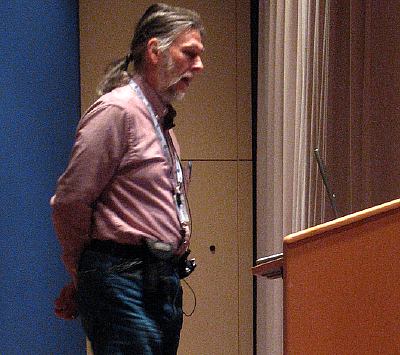
Presenter: Jim Melton (Oracle; XML Query Working Group, XML Coordination Group) [slides]
Jim Melton: Three different query languages? ("buy my book" :-) Provocative title -- "what's wrong with this picture?" SQL, XQUERY, SPARQL. SQL is for querying collections of tuples. It's closed over relational model; maps tuples to tuples. Billions of dollars spent on this over 2-3 decades.
DanC_lap: (not Structured Query Language?)
Jim Melton: XQuery is for querying trees of XML. Closure over its datamodel. Just hit CR about three months ago. Implementors have a lot to learn. But it is turning out to be very popular. A tool (?) exists for mapping both directions between SQL and XQuery.
Jim Melton: So, what's RDF? RDF is a way of representing tuples.
glazou: microphone: Not Quite That Simple :-)
Jim Melton: SQL is not well-suited to data not pre-typed (unlike RDF). RDF is identity oriented when SQL is value oriented. RDF forms a graph-model of data. RDF's graph model is not well suited to tables, being graphs.
(the humble scribe says that's totally wrong.)
DanC_lap: (really? Xquery has no support for key/keyref? hmm.)
Liam: (Liam thinks Jim is saying that it's not well suited to flat SQL tables, because of difficulty of following references)
AndyS: There is the point that the triples stored in SQL tables do not capture the data very well.
Liam: (XQuery has support for joining via ID)
Jim Melton: This graph-model represents the fundamental reason why SQL and XQuery are not suitable for RDF data. We'll dismiss OWL -- it's just an RDF vocabulary.
pfps: Hmm, quite an interesting characterization of the relationship between RDF and OWL. :-(
Jim Melton: RDF can be viewed as flat, since its 3-tuples, explicit relationships via predicates. Triples is just ER model. XDM -- tree structured, no support for explicit relationships, no tuples. I'm intimidated by RDF having billions of triples floating around, but computers can handle it.
Jim Melton: SPARQL has a great great name. It matches graph patterns, unlike SQL which is a value matching language. XQuery is a retrieval language
AndyS: SPARQL name by Dave Beckett
AndyS: S *was* "Simple" originally :-| It is now recursive as Jim has the name.
darobin: simple should be banned from participating in any technological acronym
pfps: ... and how long did that "simple" last?
karl: origin of the name SPARQL is here and here
Jim Melton: [SQL vs SPARQL example] In mapping from SPARQL to SQL -- well, it's obvious if you make certain assumptions about how the data appears in SQL. The same SPARQL could map to a very simple SQL query or a very very complex one.
Sandro: that complex sql query could be simplified again with a declared "view"
darobin: you can simplify anything with an extra level of indirection, I think the point still stands
Jim Melton: SPARQL does not get more and more complex as quickly as SQL queries do. SPARQL can be translated (except for maybe some edge cases) to SQL/relational algebra -- and possibly to XQuery.
Tim Berners-Lee (W3C): Point of clarification -- you asserted my passion was the pages should be marked up. Not true. What I want to see available is the data in the databases. Semantic markup/microformats are nice, but mostly I'm excited about database data being exposed on the Web.
Michael Sperberg-McQueen: Can you say more about the hard cases you alluded to at the end of your talk?"
Unidentified speaker: In SQL you've implicitly defined the relationships, instead of explicitly as in SPARQL. You can translate SQL into SPARQL and I like that.
Jim Melton: Yes, I agree they are roughly isomorphic, but I haven't tried that. My employer is interested in knowing how complete the mapping is.
IanJ: I don't know why one would not want to be able to convert from one query format to another for business interests.
DanC_lap: ah... ARC SPARQL2SQL Rewriter for PHP v0.2.0
Tim Berners-Lee: There is a draft activity proposal for the Semantic Web Activity which asks questions about whether/ how we should be working in this area of mapping SPARQL. Is this ripe for standardization; is this important....
Robin Berjon (Expway): You compared languages in terms of what they can be used for and are best used for; what about implementability? Which would be easier to implement in a mobile phone?
Jim Melton: The fact that we can translate SPARQL and XQuery into SQL is important to us. I wouldn't try to put SQL on a mobile phone today. It's an interesting subject.
Harold Boley (NRCC): Did you consider blank nodes in RDF and how to represent them. Are they Null values?
Jim Melton: We have considered it a little bit. Using Null is highly questionable. This is one of the edge cases we haven't really solved yet. I hope to have some information about this by XTech.
Steve Bratt: Thanks, Jim!
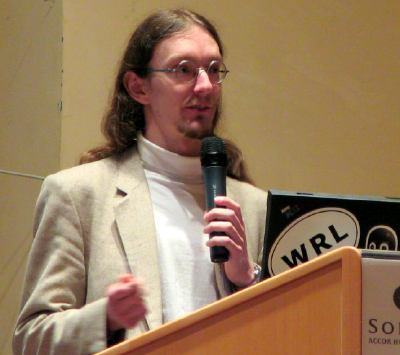
Moderator: Paul Downey (BT; Web Services Addressing and Web Services Description Working Groups and Chair of XML Schema Patterns for Databinding Working Group). Presenters and Topics:
Paul Downey (BT): This will be a very tight ship. 3 minutes of talk, 2 minutes of Q&A. Think about your favorite talks, for later in the day.
Mark Nottingham (Yahoo!): "Services and the Web." I've been at Yahoo three weeks. Talked to lots of people. Services are Good. Web Services are seen as too complex, too embrionic, not implemented in relevant platforms, questionably architectural. Web! Web services at Yahoo means Web -- not SOAP. HTTP. "Services" "REST" Yahoo hired me in part to talk about this. My concept of REST is using HTTP and URIs to get the most practical benefit from the standards around us. Requirements for REST from W3C: 1. Working Groups. XForms didn't include PUT until Last Call? 2. Best Practices (thanks TAG). 3. Go after the "real" Web -- JSON, etc. Watching This Space.
Unidentified speaker: "like soap 1.2?"
Steven: XForms WG was asked not to include PUT. That is what last call is for.
DanC_lap: huh? I don't think last call is a good time to discover important requirements. Better late than never, of course.
darobin: I guess it depends if it's your first or your seventh LC
Mark Birbeck: A whole class of applications, like WebDav, was omitted from XForms consideration.
Phil Archer (ICRA): "The First Incubator Group": Making a little metadata going a long way. Forming the XG -- the word "sponsor" was a problem. It took three months to make the XG because getting the AC-Rep email saying the right thing ... was hard. Lack of team contact --- no one to do the things you're used to from your Working Group, and stuff you think you need (e.g. set up teleconferences).
IanJ: home page: W3C Content Label Incubator Group
Ignacio Marin (Fundación CTIC): "SVG Demo": An actual SVG use case "Pintaius" a Java library which creates statistical charts in SVG -- animated, interactive, transparent. IE mouse-over charts show extra data. Different behavior in IE than Firefox. Different behavior in IE between file: and http: using object -- but okay using embed. Opera's last beta works more or less the same. Less smooth animation. Partial implementation of profiles. Last year has been good for SVG. Better support, but still work to be done. [slides for Web browsers with SVG support using <object> XHTML tag, and for Web browsers with SVG support using <embed> XHTML tag]
Chris: Opera snapshot
Mark Birbeck (x-port.net): "SVG and XForms Processing Language." Using standard markup languages to build applications. New app development framework -- completely pluggable. XHTML + XForms + etc to build proper desktop apps. [Sidewinder demo] Switching renderers between IE and Gecko without reloading document -- Sidewinder holds the document data, post validation, etc. [Demo of calculator looking very plain, then of it looking very nice and transparent.]
dom: [what IE didn't do right and Gecko did was the rendering of Unicode characters (I assume due to encoding detection)]
darobin: (but the rest is cool)
Jacek Kopecky (DERI Innsbruck): with Bijan Parsia "Standard RDF mappings for everything?" [Summary] Bumping into limits -- e.g. XML Schema doesn't give us what we need. I suggest W3C should make RDF mapping a mandatory part of all W3C work. I see some heads shaking. But this doesn't have to be hard work. This would actually help validation/constraint-checking. This is a simple task which will uncover existing issues without creating new ones. As an aside: I sure hope the microformats people will give us some GRDDL transformations.
Jeremy Carroll: At WWW2006, Dev Day has become the Developers Track -- 3 days. One of our goals is more cool stuff. Independent presenters get a big price break (people not on expense account). Deadline extended 2 more weeks. Please tell people who might be interested in that rate.
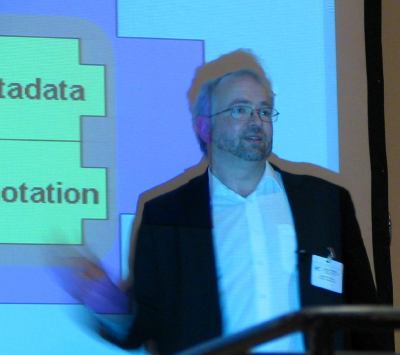
Moderator: Ian Jacobs (W3C) and David De Roure (University of Southampton; GGF W3C liaison, Chair of Semantic Grid, Area Director Technology Innovators, W3C Advisory Committee). Presenters and Topics:
David De Roure: I have a liaison role between W3C and the Global Grid Forum. W3C's side is Philippe Le Hégaret.
David Snelling: I am vice chair standards Global Grid Forum, and co-chair of OASIS/WSRF-TC. The grid had its origin in parallel processing and distributed systems. Much more commonly people talk about clusters, e.g., SETI home application. Typically a homogeneous work load, a business model that operates on a lower marginal cost. Lots of groups out there use this. I do not really consider these two as serious players. The enterprise grid is all about virtualization of enterprise resources, building a more and more effective infrastucture. Reduce the cost of ownership. Top level: collaboration grid. Instead of enterprise silos, try to get collaboration, service agreements, new business models
David Snelling: Bottom version: cluster grids. Loosely coupled distributed systems. What counts is code portability. It is not really a standards focus area. There are very few standards here, lots of players. Very specialized systems, for extremely high performance.
David Snelling: Enterprise grid: The data center is the equivalent of a global call center. Creation of a structured whole from the parts. Examples: Fujitsu, Sun n1, Oracle 10g. Run your required services efficiently. Collaboration grid: The boundaries between organizations is the focus. You use the enterprise grid tools but among enterprises, laboratories, research centers, or collaboration like chemical plants. You have IP sharing, privacy, all interesting challenges. There are places where the grid community has adopted Web services frameworks, but they are in the experimental phase. There are issues of virtual organization, discovery, security, etc. Convergence: Collaboration and enterprise grid convergence, technical convergence from both type of grids. Both groups need to come together and need standards in this space. Where does it matter to W3C? Cluster and enterprise grids are consumers of W3C specs, thank you. But they are usually isolated in corporate boundaries. In the Web: the goal is to go beyond those boundaries. Collaboration grids are different. Naming, identity and addressing, service and resource discovery, dynamic composition are all common problems. We will get to know each other more than before. Once we have a standard framework in place, we get more into standards space. The concepts of the Semantic Web.
David De Roure: slides, see also. In Europe when we talk about future grids, it is the semantic grid. Knowledge entities are bound to each service and there are bindings among them. The grid community already had issues like knowledge, etc, and they were pleased to get that expressed in the Semantic Web. We see significant opportunity for Semantic Web, good circumstances for a Semantic Web win. Social environment exists and the community is growing. There is also a research agenda.
Don Deutsch (Oracle): Enterprise Grid Computing. Besides working on Oracle's standards participation, I am also president of the Enterprise Grid Alliance (EGA). Grid computing landscape: grid is an evolving/emerging technology. It is a bit like the elephant looked at by the blind folks. No question it has scale opportunity. We see adoption becoming more widespread. Primarily in the single large problem of distributed computing. There is also an ecosystem, increasing number of providers serving the grid communities. Also institutions that provide standards.
Don Deutsch: EGA was formed with a narrow perspective: grid in an enterprise. Within and between data centers, behind the firewall. Dealing within and between legal entities. The 'business' in the large sense. Large commercial applications (erp, crm). Technical applications run 'after hours', large CPU conception, not really transaction oriented. Components: networks, application servers, databases, servers, storage, management frameworks. EGA was formed 20 months ago. It is a vendor neutral consortium with global participation, global in nature. Its non-broad mission: accelerate grid technologies in enterprise data centers.
Don Deutsch: EGA was bounded 60/40 technical and marketing org, not a traditional standards body. The preference was to find solutions that already existed. If a specification was available, take it, or to an organization better suited to develop one. Only if those all failed, then EGA would develop its own technologies. Like W3C, one company one vote, royalty free. Strategy: focus solely within a single data center, and on commercial applications. Having done that, move to two directions. Cross enterprise applications and technical applications. Finally move to the collaboration type phase. 5 working groups: reference model, security, component provisioning, data provisioning, utility accounting. We are chartering some new groups.
Don Deutsch: EGA has a marketing focus, too, on education and recruiting, barriers to grid adoption, reluctance to risk mission critical applications, immaturity, cultural attitudes, trust and accounting models, licensing and resource sharing concerns.
Don Deutsch: 6 areas of concerns. 1. Confusion about enterprise grid computing. EGA produced a reference model (available on EGA Web site). It is a layer in the middle for working, this was our first technical product. Second version will come within the next months or so. 2. Cross-vendor interoperability. We have a document for data and storage provisioning. 3. Billing and accounting. Enable pay-per-use metering and chargeback capabilities. It is a big issue, though not as sexy as the technical. 4. Security and user authentication. 5. Standards. Drive our requirements into other organizations. 6. Global enterprise grids. We have regional organizations.
Danny Ayers: The grid material I have seen so far can connect to the XML stuff nicely. How much are the Semantic Web communities communicating with that.
David Snelling: The resource description issue is core to the grid space. At the next stage we have to describe capabilities. A lot of work looking at resource description projects. Put those together and RDF type analysis on them. Find out what the problems are, and what the right solution to that is. Can we build semantic tools. The grid community is still looking at the issues.
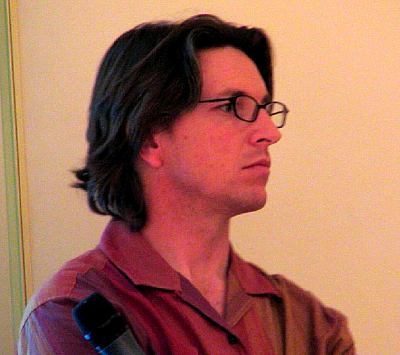
Moderator: Jonathan Marsh (Microsoft, Web Services Addressing Working Group, Chair of Web Services Description Working Group). Presenters and Topics:
Jonathan Marsh: A number of Working Groups experiment with formal methods. Before this, I had not very much knowledge about the topic. Panelists are Liam Quin (W3C) and Jerome Simeon (IBM), Dan Connolly (W3C), Arthur Ryman (IBM) and Charlton Barreto (Adobe).
Liam Quin: I have many hats: XML Activity Lead, XML Query Working Group. XQuery started in 1998. Today is a Candidate Recommendation. Everybody has heard of XQuery, some have used it. Today I'll talk about the XQuery and XPath specifications, and the XQuery formal semantics. XQuery Formal Semantics gives the formal definition of static data typing.
Liam Quin: XQuery wanted an algebra (like relational model) too. Important to be able to have mathematical proofs. We've written the specs two times (formal and in English). The benefit of formal semantics is that the complexity of the prose description is drastically reduced.
dom: [there is a wiki page on the topic of this session, although it could use some contributions]
Liam Quin: Formal semantics is a specific subset of the XQuery model. We formalized using inference rule notation. We formalized normalization expressions into a smaller core grammar. Convert an expression into a smaller core grammar... harder to read for humans, but better for computers. You have to decide which part is normative.
DanC_lap: (sandro, their inference rule markup is kinda interesting, as a RIF use case. It's sorta marked up in structures suitable for translation to latex, but not as far as mathml content notation)..(can't have two normative descriptions? I disagree. if they're different, there's a bug. why decide in advance where the bug is?)
Liam Quin: There are some non-normative parts but it is all formal in the formal semantics spec. English versus formal semantics specs... Readers of formal semantics spec are fewer than readers of English prose spec.
karl: [Use formal languages when possible]
Liam Quin: An example of an inference rule... about the type of a variable, a precondition, a situation; under the line is what we infer. Formal semantics is useful also as a guide for implementors. Here is an example from the "galax" implementation. It shows a normalized expression.
DanC_lap: (I spent some time comparing the markup used in the xquery spec and what wikipedia does. pretty interesting.)
Liam Quin: XQuery was a huge amount of work. You should not formalize stuff which is already formalized elsewhere. Many optimizations rely on the formal semantics. For (many) endusers, it is not relevant directly. Formal semantics is a huge benefit in the long run and it helps to make the English prose understandable.
Patrick Curran (Sun Microsystems, QA Interest Group): Formal semantics have a value for test cases. You might automatically generate (performance) tests.
Liam Quin: Yes, that is a benefit. Another benefit is the translation into another language.
Dan Connolly (W3C): "DTD/UML/OWL" [slides]. My research is investigating (chaotic) systems like the Web. Statistical approaches are great, like pageRank... Many people do check over the Web, via the validator, and do not download the DTD. lex/yacc was the obvious way to specify a formal language at that time. Namespaces help grounding things in the Web, so I can make formal links in the Web. You can have links in between the schemas. David Orchard is mainly working on this TAG issue. The white board drawing resulted in the next drawing... The UML diagram on the issue (versioning)... compare slide 10 and 11: UML captures some properties between classes, constraints... We created an OWL representation, generated via XSLT. UML was the one notation which most people in the group understood. We had white board discussions, then made consistency checking with the machine, etc. Some additional information about the methodology
Daniel Veillard (Redhat): I have some implementors feedback on XML Schema and RELAX NG: The second one was very fast. With XML Schema, we are not yet finished. RELAX NG has a formal semantics in Haskell notation. This is an example of: if the concept is sound the English prose version and a formal version will be clear. If you are unclear from the start, both versions will be bad.
Dan Connolly: RELAX NG came second. The formal stuff of RELAX NG was presented to the XML Schema Working Group. The group said that it was not interesting.
Liam Quin: It is important not to develop the semantics afterwards. So that you can say "would that change have an impact on the formal semantics?" It was very productive although many people in the XQuery Working Group did not have time to stay on top of the formal semantics specs.
Jonathan Marsh: As for WSDL, we did the Z notation earlier as well.
Charlton Barreto (Adobe): [slides] Summary: ...Symbology of pi-calculus. Matching names becomes an atomic operation [explains the operation] Example of encoding in CDL: any CDL has reaction rules which describe the semantics. We use the encoding and the reaction rules.. Preservation of function behavior is important. That is functions on the arcs in the drawing. [gives papers on the topic]
Jacek Kopecky: You said you need formalisms but your model already is based on formalisms. So are there any other reasons than "circular" ones for formalisms?
Charlton Barreto: We needed to be able to make clear that what we do can be validated. There were strong drivers who pushed for completeness and verifiability.
Arthur Ryman (IBM) and Hugo Haas (W3C): "Using Z Notation to Specify WSDL 2.0" [slides]
Hugo Haas: Mainly Arthur wrote the draft and understands the topic in detail. Arthur joined the WSDL Working Group. He had the goal to make sure that the spec does not lead to interoperability problems
dom: The Z Notation: a reference manual
JacekK: WSDL with z notation
dom: [linked from wikipedia Wikipedia]
Hugo Haas: [shows type checker which has been used for the spec] [comparison to the Rosetta stone... WSDL Working Group participants are priests] Others had not worked with Z, so we did our "own" layer. Z nirvana according to Arthur. In our Last Call, 90% of the comments were in the part of the spec which did not use Z so Z was very successful in making things clear.
dom: [Formal specification IS a QA Best Practice!]
karl: [Use formal languages when possible]
DanC_: (re MathML for this stuff... I wonder if it's expressive enough for stuff like these Z things and the XQuery type system judgments. If anybody knows mathml and such enough to discuss that with me, I'd appreciate it.)
IanJ: See also: Visualizing Z Notation in HTML Documents (1998)
dom: Use formal languages when possible in QA SpecGL
Hugo Haas: If we would allow normative status for such notations, we could have normative versions of spec that other standards bodies border on.
Ivan Herman (W3C): As I used Z, it was perfect for WSDL. But I am not sure if it is doable if you want to formalize XML with this.
Hugo Haas: Our formalism is at the language level e.g. an optional property has a different type than a mandatory property. Such characteristics are independent of the topic "Web services."
Henry Story (Sun Microsystems): > All formal languages are based on set theory. Would we need only a kind of rule language for all specs?
Hugo Haas: I asked some questions to RDF experts, i.e., could we just do the RDF mapping? The answer is: once we have rules, we have a formal notation based on RDF.
Richard Tobin (Edinburgh [HCRC Language Technology Group]): The Infoset spec had a non-normative RDF schema for the infoset. We did not have a tool to check this, though.
Alistair Miles (Council for the Central Laboratory of the Research Councils [CCL]): A question inspired by Dan's first slide. You said "the Web is a chaotic system." I think it is rather a "complex" system. The evidence is that some Web locations are attractive (like Google). The Google ranking algorithm increases the attraction. So could mathematics help us to understand this complexity?
Dan Connolly: There are a lot of Web conference papers on this.

Moderator: Kevin Kelly (IBM; XForms Working Group, Hypertext Coordination Group, Chair of the Compound Document Formats Working Group) [slides (PDF), demo (requires Firefox Deerpark alpha with xforms.xpi installed (FTP)]. Presenters and Topics:
John Boyer (IBM): "Intelligent XML Data Model" slides] It could be a microformat as well. Some duplication within different markups. Merging markups in "backplane"... An attempt to give an idea what it gives you to put different markups in a common framework.. Multiple presentation techniques may be based on one XML data model. [Demo: filling in data into the XML by calculation over filled in data]. Backplane is where plugged components are connected. Event concept should be the same across markups. Many topics have to be addressed when doing unification. Handlers for existing markup is based on script based handlers.
Steven Pemberton (W3C): "Events" [slides]
SusanL: Steven: Speaking on events because people noticed S T E V E N is an anagram for E V E N T S. I argued Pemberton is not an anagram for backplane.
karl: Source: WordNet (r) 2.0 1: the amount added to the cost to determine the asking price. 2: detailed stylistic instructions for typesetting something that is to be printed; manual markup is usually written on the copy (e.g. underlining words that are to be set in italics)
Mark Birbeck (x-port.net): "Data Submission". Submission is serializing data, sending it to an endpoint, you get some data back. Typical use is forms (HTML, VoiceXML). Also in AJAX not replacing current page. What's missing? Proper mapping to a DOM API. More events. Synch of events
chaals: Doug Schepers, Vectorial:
Doug Schepers (Vectorial): You could cover much of the use cases if you use a simple replace mechanism.
Steven Pemberton: This is what we want to do.
Al Gilman: "Accessibility" [slides]
rohit: microbackplane? macroformats? what hath we wrought? ... :)
sandro: now why have I have I never seen a talk given by just expanding parts of an outline on the screen...? funky.
tantek: it's firefox
Al Gilman: Goal: Accessible Dynamic Web Content. The platform API should match with assistive technology. Views should be usable and adapted. Accessibility has to be restored to existing applications. We must be able to get to a screenreader view through the API.
tantek: but applications turnover so fast, is that the right time tradeoff? rather than focusing on educating developers to build more accessible apps from scratch? and then just let time and natural turnover take care of things?
leesa: building accessible apps from scratch is a debatable point without this. depending on your environment and how complex it is. because the contract between the browser and accessibility API was broken. kind of
KevinLawver: Couldn't AA apps do most of this today if MSAA gave them access to the DOM as it updates? That seems to be the big stumbling block for at least screenreaders. There's no way today to tell a screenreader to DOM changes.
leesa: depends if you know what accessible object to map it to in the first place. if there is one defined for your custom widget
leesa: And a lot of stuff was just not well supported by the states to syntax mix depending what lang you are in. happy to go over it in more detail
Kevin Kelly: [shows tax forms that use XFORMS, SVG, XHTML]. without a common model there is quite some scripting necessary to achieve this. [demo (requires Firefox Deerpark alpha with xforms.xpi installed (FTP)]
DanC_lap: (this tax example; can anybody tell what software he's using?)
dbaron: IIRC, he's using Firefox with the XForms extension
Guido Grassel (Nokia): You said the declarative approach should be preferred over the scripting approach. Is this true? The declarative approach might easily also become very complex.
John Boyer: Example customer tried to do a system following the usual JavaScript approach. Estimated 1 month to do it. Declarative approach delivered a finalized form immediately.
Steven Pemberton: The effort is about size **1.5 / Saving bigger for bigger projects
JibberJim: hurrah, Xforms will save your javascript programmers sanity!
KevinLawver: I worry about the initial sanity of the developers if javascript drove them mad. They must have been fairly close to the brink to begin with.
JibberJim: KevinLawver to want to do javascript you need to be close to the edge
KevinLawver: Why, because it works across browsers?
Mark Birbeck: The declarative approach is far more efficient and facilitates doing functions independently
Rich Schwerdtfeger (IBM): Binding in JavaScript has to be done by hand, if you use XForms the user agent does it for you.
Tantek Çelik (Technorati, Invited Expert): Who is your intended audience?
Steven Pemberton: What we present is not declarative in the first place. You can use scripting. Declarative part is on top of it. This helps to plug things together.
Tantek Çelik: Somebody able to do scripting should be able to do this?
Al Gilman: Two audiences are in focus.
Steven Pemberton: This is not about XForms. Events and submit (serialization, sending) is much broader concept.
Rich Schwerdtfeger: [comment on productivity]
Mark Birbeck: Two ways to increase productivity. Declarative approach and libraries. A lot of good innovation in this space.
Dean Jackson (W3C): Where do think this work should be done?
Kevin Kelly: CDF Working Group? I don't know.
Dean Jackson: I don't know either. I don't think it should be the Web APIs Working Group.
KevinLawver: What I said without the mic: Events belongs in Web API.
tantek: last time this came up in a big forum, it was a HyperText CG thing
Mark Birbeck: I can't see it either.
tantek: where is Steve Zilles when you need him?
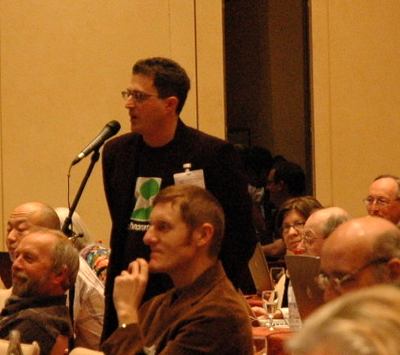
Moderator: Paul Downey (BT, Web Services Addressing and Web Services Description Working Groups, and Chair of XML Schema Patterns for Databinding Working Group). Presenters and Topics:
[Except part of Single Transferable Vote, Lightning Talks B are unrecorded. See IRC log: Chad vote on "Which was your favorite session?" takes place. IRC comments are below.]
Jonathan Marsh: "Single Transferable Voting and the Art of Consensus" ["Polly Ondafringe," "Quigley Quietus, "Smiley Miway-Hiway"]. I have found it work well and has brought the group to coalesce. The whole Working Group has to do this on a case by case basis.
tantek: mnot, here is another include pattern which we have found necessary for several real world use cases (limited to local includes from within the same document)
tantek: where is the source for microformats in 1997?
tantek: BTW, microformats is not just "semantic class names" though microformats (often) use semantic class names (other times just a simple rel attribute)
karl: tantek, origin of microformats
tantek: this is a common misconception
DanC_lap: I made a counter-proposal to <frame> that was pretty microformatty... at least it was using class/rel for semantics. that was in 1994 or so, i think
DanC_lap: ah... aug '95. http://www.nyct.net/~aray/htmlwg/95q3/778.html
DanC_lap: class and rel were in html2
tantek: microformats applies additional deliberate design and process constraints to the notion of using semantic class names. that's the addition that distinguishes microformats from semantic class names (which have been around as long as "class" attribute has been around)
DanC_lap: right; I think the "I was doing microformats in 1997" claim only refers to the class/rel stuff, not to the methodology.
tantek: right. doing semantic extensions to class and rel is necessary but not sufficient to doing microformats.
Florida: chad, question: Which was your favourite session?
tantek: hmmm... i believe there are more thorough game theory analyses that reveal *other* problems with single transferable voting
chaals: oh. This is what australians call "optional preferential voting". The optional isn't always used, but preferential is the norm for elections
tantek: DanC, the wikipedia reference is on the record. note table about 2/3 the way down the page. of which voting systems have which flaws
chaals: see also Voting System
tantek: is "vote:" a new proposed URI scheme?
RalphS: DavidOrchard: WS Addressing and choreography(?) has used chad a lot and I encourage others to use it. But one flaw is that it does not detect a position that everyone could live with
Chris: does chad have a paper trail, or is that too expensive?
RalphS: DavidBaron: There's lots of research on voting methods. STV might not be the best for W3C matters. It's actually not good for dealing with similar alternatives.
RalphS: JonathanMarsh: the library will support other voting methods, e.g. the British Columbia method
JB: It's also important to check that the software works
dbaron: this may be of interest: Criteria in evaluating voting systems
Tantek Çelik: If the objective is to filter through multiple options, I'd like to challenge this. First, I'd like to challenge the assumption that choices are static.
schepers: I want to vote *against* things as well
dbaron: schepers, other voting strategies are better at describing votes against things; STV is bad at that
KevinLawver: Yeah, I like voting against things as well. maybe allowing 3,-9,-10,5...
Rotan: vote: 0, -0 and zero, nill, null, nil, and all other variants.
dbaron: Another potentially false assumption is that the options are strictly alternatives; some may be alternatives to subsets of others, etc.
Yves: vote: `cat /etc/password`
dorchard: I think Tantek is being a process offender :-)
timbl: Suggest that the votes for 9 are for the bar
Rotan: Another problem I see is that voting is visible during the vote. I'd prefer STV to be done in secret, and then see the results. Otherwise the vote is influenced by early voters.
chaals: chad, question: should we repair to the bar?
Chris: oh no! microformats is still the winner. so we have to re-run microformats instead of drinking!
tlr: vote: `dd if=/dev/urandom`
dbaron: So, yeah, I was wrong about IRV and what that wikipedia page calls Clone-independence
Steve Bratt thanks the meeting planners Coralie Mercier, Amy van der Hiel, Alexandra Lavirotte and Susan Westhaver; the program committee Al Gilman, Kevin Kelly (IBM), Mark Nottingham (Yahoo!), Amit Sheth (Semagix), Susie Stephens (Oracle), Rachel Yager (Financial Services Technology Consortium), Yves Lafon, Susan Lesch and Daniel Weitzner; and the scribes.
RalphS: [adjourned]
[End of minutes]
[None recorded]